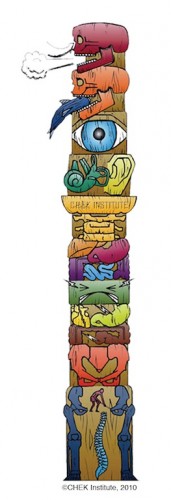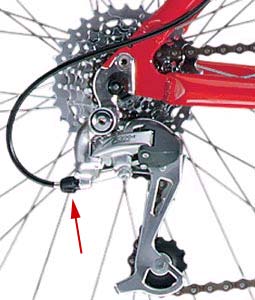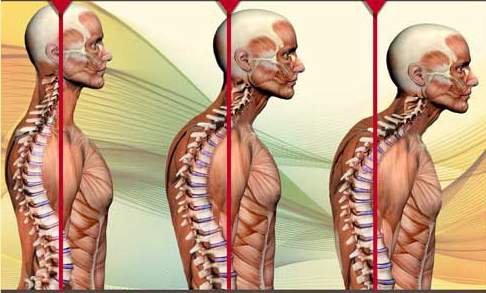CHEK TOTEM POLE Part 9: SACRUM AND COCCYX
Happy Thursday to You!
I hope you are all enjoying beautiful sunny days wherever you are.
My day was full and rich with experiences yesterday. Amidst my business, I managed to get in a great lunge and squat session with some reverse Swiss ball crunches.
I’m feeling great with my lunges lately and was comfortable lunging sets of 3 with 225 pounds. I coupled them in a circuit with squats and just did as many squats as I could with the same weight I’d lunged with. I finished my workout with three sets of reverse SB crunches.
All in all, it worked out to be about 45:00 of hormonal joy. Since returning home, I’ve gained five pounds from having a regular training routine in a proper gym ☺, and sleep, with Vidya’s food!
I’m feeling great again.
CHEK TOTEM POLE Part 9: SACRUM AND COCCYX
We’ve come a long way in our totem pole dialogues now. We are down to the second to last symbol in the CTP, which represents the functional relationship between the central nervous system (CNS) and the sacrum and coccyx.

The filum terminale is the tail of the spinal cord. The filum terminale attaches itself to the coccyx, which is the little tail of bones at the end of the sacrum.
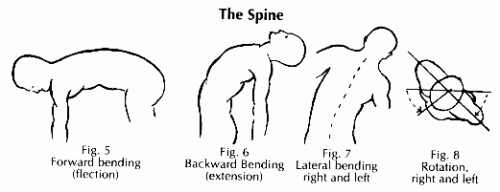
When we bend forward or “flex” our spinal column, the spinal curves all go into flexion, functionally lengthening the spinal column.
When we extend or bend backwards, our head gets closer to our tail, functionally shortening the spinal column.
Nerve tissue has a very finite level of elasticity and if lengthened more than about 4% of its natural length, injury will result.
Because the CNS and peripheral nervous system is so critical to our function and survival, our bodies are designed such that the coccyx acts to maintain optimal tension in the spinal cord and nerve roots.
An easy way to understand how the coccyx functions to maintain optimal tension in the nerve roots and spinal cord is to think of how a bicycle derailer functions to keep chain tension optimal.
As you can see in the picture above, the derailer is a spring loaded arm with a pulley at the bottom (see the shaft and pulley with the chain coming out the bottom to the right of the red arrow).
As the cyclist uses the bigger sprockets (easier to pedal), the chain gets functionally shorter and the derailer swings forward under spring tension to allow the chain to lengthen to fit around bigger gears.
As you shift gears to the smaller (harder to pedal) gears, the derailer swings backward, letting the chain get longer while at the same time, keeping even tension on the chain.
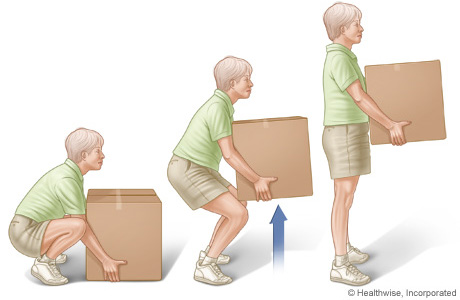
When we bend forward to pick up boxes or other objects, our spinal column lengthens, which causes a stretch force on the CNS and nerve roots.
To accommodate the length change in the spinal column and spinal cord, the coccyx flexes or bends forward, functioning just like a chain derailer. When we stand up again, the coccyx extends or bends backward to keep optimal tension in the CNS and nerve roots.
If for any reason there are adhesions along the spinal cord or nerve roots, the body often shortens and/or leans to the side of the adhesion to minimize unwanted tension and possible tearing of the spinal cord and/or nerve roots.
Over time, the body will progressively collapse into a variety of poor postural formations, which themselves can become quite stressful and problematic to other systems of the body and disrupt mental-emotional balance.
CONCLUSION
The sacrum and coccyx are where they on the CTP because any problems in the natural motion of the spinal cord or coccyx can, and often does cause long-range problems that look like the problem in and of themselves, but are typically symptoms of adverse mechanical tension in the CNS and peripheral nervous systems.
In our next edition on the CTP, we will discuss the last symbol of the CTP, the slave joints.
Rory heads home today, sorry to see the Falcon go, its been great with him here, but we will catch up to him next week in Toronto. Thanks Rory for your friendship!
I will be taking the day off tomorrow, so we will have a Tao-Te-zen day and I’ll finish the CTP series on Monday.
Love and chi,
Paul Chek
